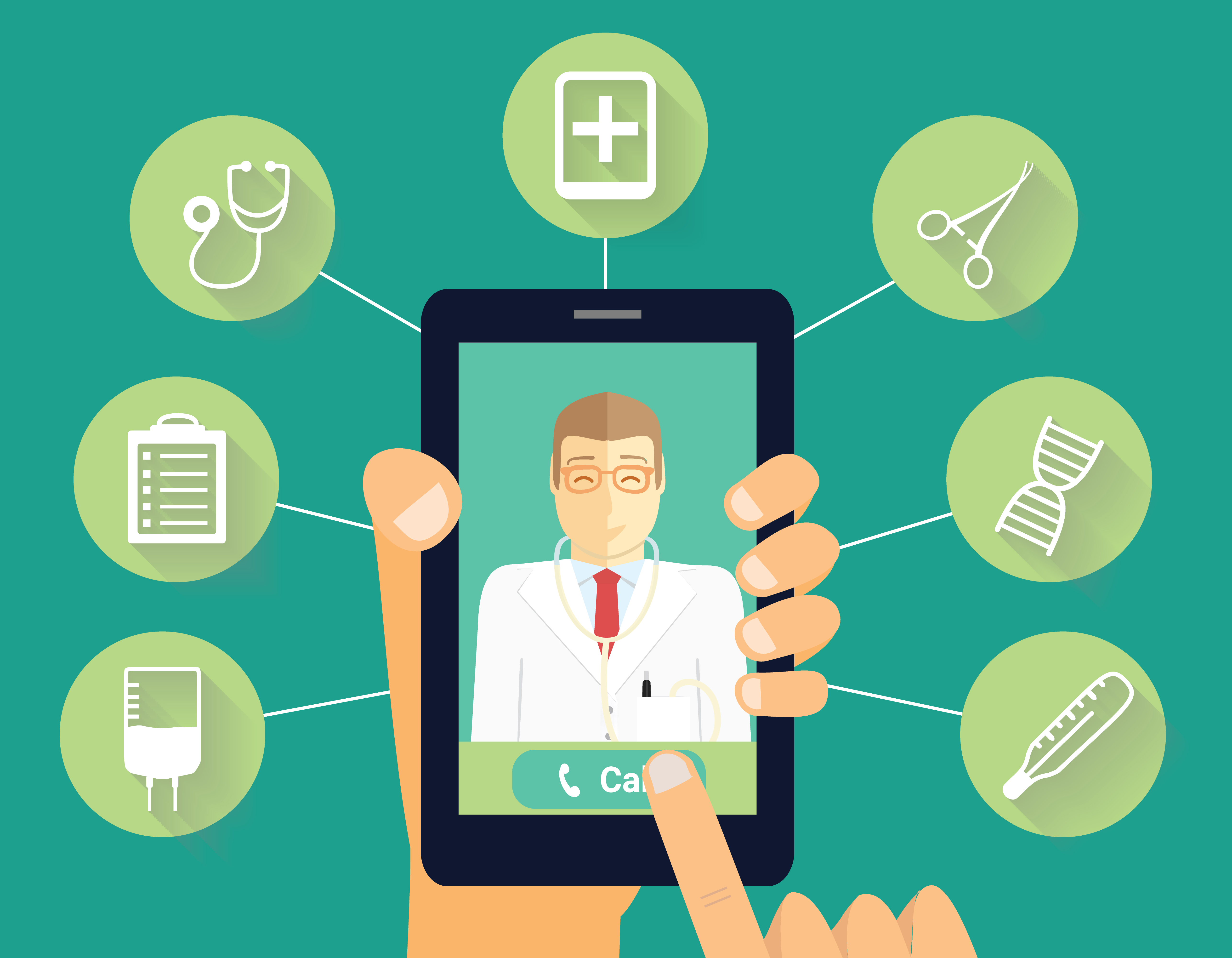By Matthew Zajechowski, content strategist, Digital Third Coast.
 The use of Telehealth services has seen remarkable growth during the COVID-19 pandemic. Recent research found that 67% of Americans have used telehealth services during the COVID-19 pandemic, which is up from 46% prior to COVID-19. One might wonder if this growth is temporary or poised for more long-term growth post-pandemic.
The use of Telehealth services has seen remarkable growth during the COVID-19 pandemic. Recent research found that 67% of Americans have used telehealth services during the COVID-19 pandemic, which is up from 46% prior to COVID-19. One might wonder if this growth is temporary or poised for more long-term growth post-pandemic.
To learn more about the growing trend of telehealth use, my agency worked with a data management firm to survey the American public about their experiences using telehealth during COVID-19 and whether or not they plan to continue to use these virtual medical services in the future.
Telehealth and Covid-19
One immediate observation that we learned as a result of this analysis is that 71% of Americans are currently fearful to visit their doctor’s office due to COVID-19. Because of these fears, many people have shifted towards using telehealth services during the pandemic. While 63% of respondents were originally apprehensive about their first telehealth visit, 72% reported enjoying their first telehealth experience.
What patients like most about telehealth
Why do patients prefer seeing a doctor virtually as opposed to in-person? Convivence safety and flexibility with appointments were the top responses. Many patients are shifting to telehealth as a means to avoid potential virus exposure.
Shorter wait-times are also driving people to telehealth appointments during the COVID-19 pandemic. Patients reported spending less time both between scheduling the appointment and the visit as well as time spent waiting in a virtual waiting room to be seen.
Access to care is another positive trend from increased telehealth use during COVID-19. Eighty percent (80%) of surveyed respondents believe telehealth has improved their ability to receive access to care during the pandemic. Seventy percent (70%) feel that telehealth provides adequate care and 65% believe telehealth provides accurate diagnosis to symptoms.
Telehealth visits also have the potential to replace some medical visits depending on the severity of the ailment. Sixty-six percent of our surveyed respondents feel telehealth will ultimately end up replacing in-person doctor visits that don’t require hands-on exams; 69% said they are less likely to use an ER or urgent care for non-life-threatening visits in the future if telehealth becomes more available.
Continue Reading

By Liz Townes, consultant, Freed Associates.
As the nation slowly re-opens amid the COVID-19 pandemic and patients return to doctors’ offices in-person, demand still remains high for telehealth visits. According to a report earlier this year, virtual health care visits in the U.S. are on pace to top a record 1 billion by year’s end. What makes that statistic all the more remarkable is that just 24 percent of health care programs in the U.S. had an existing virtual health care program at the start of 2020.
This year’s rapid increase in demand for telehealth has been borne out of necessity, given that due to the pandemic, in-person patient visits were quickly deemed unsafe or infeasible nationwide. Many prior rules and regulations pertaining to telehealth usage, such as those around HIPAA regulations and payer coverage standards, were relaxed to encourage telehealth use.
Providers and patients alike quickly cast aside any prior concerns they may have had about telehealth quality, efficacy and ease of use, particularly for using telehealth to resolve pandemic-related health concerns. Of the more than 1 billion telehealth visits projected for 2020, noted above, 90 percent are related to COVID-19.
It remains to be seen if the relaxed regulatory and payer standards for telehealth will remain long-term. Many providers are naturally hesitant to invest further in telehealth right now, preferring to see what CMS and other payers decide long-term regarding telehealth visit rules and reimbursement standards.
Continue Reading
The healthcare sector is digitizing at an amazing pace. According to Adroit Market Research, global medical healthcare eCommerce is anticipated to be over $435 billion by 2025. Initial digital transformation drivers were the aging population and the willingness of consumers to do their own online research. However, the COVID-19 pandemic has proven the value of medical device eCommerce as medical suppliers must increasingly rely on digital channels to service customers and grow their business.
eCommerce and the Medical Supply Industry
The B2B healthcare market is different from other forms of eCommerce. Maintaining compliance with complex and myriad regulations is a major challenge and has kept some players out. But for those who navigate the landmines of HIPPA and other medical data security issues, the medical equipment eCommerce niche is a highly lucrative market. Visit https://www.thehealthhub.com/ to get more information about advanced medical equipmnets.
Hospitals, clinics, and individual practices are relying more than ever on eCommerce to procure their medical supplies. In 2018, hospitals were the largest category of eCommerce healthcare buyers (over 53%). Medical devices account for 34% of eCommerce purchases in the healthcare space.
In 2019, the median age for purchasing professionals was 45 years old. This is the internet generation. They look to the internet from their smartphones, tablets, and laptops for solutions to their problems. Product research begins with an internet search. Amazon understands this and so should you.
In 2017, Amazon announced that Amazon Business would enter the medical supply and healthcare market and today they count 84 of the top 100 health systems as their customers. Not bad for less than three years of work.
What Medical Device Buyers Want
Like all professional buyers, medical supply procurement professionals are looking for exceptional customer experience. In 2020, customer experience is the main differentiator, even over price and product. And people are willing to pay more for an exceptional experience. It’s that important.
In the medical supply industry, sellers are using their eCommerce channel to provide proof of their dedication to customer satisfaction and client success. Something as simple as offering content that helps customers develop plans for rationing PPE and hand sanitizer or offering sales and support outside of regular business hours or providing for expedited and emergency deliveries provides buyers the customer experience they demand. In a post-pandemic environment, proving the strength of your supply chain is incredibly reassuring.
As purchasing agents are forced to do more with less and procure supplies from multiple sources, they are looking for a process with as little friction as possible. An eCommerce option is the solution they seek.
The path to purchase generally starts with a Google search. 94% of healthcare equipment buyers first research products online. It’s the beginning of the self-serve process that includes finding product specifications and technical information as well as case and use studies. These busy professionals appreciate a digital RFQ process and they also want assurances on product availability and your ability to deliver on time. Transparency in inventory status is valued in any supply chain, but it is especially critical in the medical supply market. An eCommerce site complete with live inventory levels lets medical supply buyers know what you have available.
Continue Reading

Technology has impacted the way we do many things. Where it has become a partner in progress is in the healthcare industry. Many developments that were once the subject of science fiction have become reality in recent years. The COVID-19 virus has also pushed technology in healthcare into new places reaching greater heights. In this article, we will take a look at a handful of the most significant healthcare trends to develop this year.
1 – Telemedicine
Telemedicine has become a vital player in the healthcare industry. It has already improved it considerably through the remote delivery of medical services. Before the COVID-19 pandemic, telemedicine was still mostly an idea that was not seeing a lot of action. Now, telemedicine has become a valued partner in the hands of doctors, nurses, and other medical professionals. As a result, it has a promising future in the delivery of healthcare to patients who are at home or cannot travel.
Reasons Why Telemedicine Is Growing
Telemedicine has assisted in handling various healthcare sector challenges. They include such things as:
– The increasing cost of the delivery of care
– The decline in health outcomes
– The increased number of patients with chronic diseases who are living longer
– An increase in competition
What Is In The Future For Telemedicine?
The coming years are going to be interesting. Telemedicine will continue to evolve with advancements in technology. Things to expect in the future may include:
– Telemedicine solutions decentralizing the healthcare system
– Better remote health insurance coverage
– Easier to use healthcare applications
– Telemedicine and small practices partnering
– Innovative health software gaining popularity
There is no doubt that telemedicine is trending today. With the ongoing growth in the world of technology and medical technology, in particular, telemedicine is going to pave a new way into the future.
Continue Reading
 New technology has brought several changes to many different industries. One such industry where technology has become a valuable partner is in healthcare.
New technology has brought several changes to many different industries. One such industry where technology has become a valuable partner is in healthcare.
From assisting doctors in every aspect of their role in practice to streamlining operational facilities with data storage and information sharing, the face of healthcare has changed considerably. As technology is always evolving, it is safe to say that it will continue to contribute to the healthcare sector.
In this article, we will explore three of the forces that will have a hand in shaping the future of healthcare.
Artificial Intelligence (AI)
The role in healthcare played by AI continues to grow. Examples of this include chatbots, AI tech, and AI-assisted software.
Chatbots
Chatbots are used to interact with patients. They ask and answer questions about treatment plans, diagnosis, and much more. The chatbots will “learn” what a specific patient is going through and provide answers that are related to the information it receives. These tools help doctors a great deal by assisting patients in a more effective and accurate means. Chatbots also help doctors who have full schedules and must see many patients in a single day. These virtual appointments lighten that load.
AI Tech
AI tech is used to convert patient records into easy to read digital data. When it is in this format, easily accessible medical records are created and stored on a database. The database will hold a massive amount of patient information and is shareable to anyone who has access to the network. Information can also be easily updated from the database. It has increased communication between medical professionals and made diagnoses must easily in many cases.
Continue Reading

Treatment of colorectal cancer stays in the focus of medical attention due to the high prevalence of pathology and complicated diagnosis making. Systemic therapy is becoming more asked-for as it can be administered instead of invasive interventions and has proven its efficacy at the advanced cancer stages.
Chemotherapy is the most studied type of systemic treatment. It has been applied in the clinical practice for over a few decades. Chemotherapy for colon cancer treatment in Germany includes the administration of both innovative and conventional chemotherapeutic agents with the best safety and effectiveness profiles.
When chemotherapy is performed
According to the colon cancer stage, therapeutic aims, patient’s age, and general health state, chemotherapy is given in the following modes.
Neoadjuvant chemotherapy is administered prior to surgical intervention. It shrinks the tumor so that the specialist can remove it completely or with fewer surgical complications. In certain cases, chemotherapeutic agents are given along with radiation therapy, as they make the tumor more sensitive to the irradiation.
Adjuvant chemotherapy is administered after surgical intervention. Its main aim is to kill cancer cells that may have been missed. These include pathological foci in the liver or micrometastases in the other localizations. Adjuvant chemotherapy is a measure of relapse prevention.
Palliative chemotherapy is administered when the tumor is advanced and has already spread to distant organs. Its aim is prolonging life and alleviating symptoms. Palliative chemotherapy is performed in specialized hospitals or, sometimes, on an outpatient basis.
Continue Reading

Back when there were doctor’s house calls and the neighborhood doc was everyone’s physician, it was easy to connect with patients. And while you might think that the internet gives you more avenues to reach out, patients become apprehensive behind a screen when they aren’t familiar with their doctor.
With all the choices in the medical field, it can be overwhelming to choose a doctor who can put their patients at ease, so they’ll keep coming back for treatment. The doctor-patient relationship is an important one, and there are some key things you can do to connect with your patients in the modern age.
Remain Transparent
Patients appreciate a doctor they can count on and who communicates with complete transparency. They want to know about their doctor’s specialty, who they are, and how they treat their patients before they even walk through the door.
Doctors might have their credentials hanging on their wall or their website but that only tells part of their story. One way to connect with patients and explain a doctor’s specialties in a way that patients can relate to is through a medical PR campaign. Bridging the gap between patient and doctor is a great way to build a trusting relationship.
Be Available
When establishing a doctor to patient relationship, the doctor must be available to the patient. There’s nothing more frustrating for a patient than to reach out to their doctor and not receive an answer. The only thing worse is having no way to contact the doctor at all.
To open lines of communication and keep them open, doctors should have a way to contact patients, and patients should have a way to contact their doctor. This connection can be through email or phone, but communication must be a two-way street to be effective.
Continue Reading

Online privacy and security have become a concern for many people as well as businesses all over the world. With the rise of ubiquitous internet, a lot of individuals now appreciate the fact that their private browsing data is always open to hackers and other third parties. For instance, some internet service providers have been accused of scooping and selling user data without their consent which means that you could easily lose your online privacy if you don’t take appropriate measures.
And it isn’t just the internet service providers, other leading tech giants, such as Facebook and Google, can afford to provide free services since they collect and use data to understand their user habits better to display appropriate ads.
Virtual Private Networks (VPN) offer a quick and easy option to help protect your identity online. VPNs work by creating a virtual network that routes all of your smartphone’s or PC’s network traffic through an encrypted tunnel and out through the other side making it seem like you are in whatever location the VPN server is located.
However, choosing the right VPN isn’t a decision that can be taken lightly. With so many options available out there, it can be challenging to choose the right VPN that will suit your unique needs. Luckily, there are lots of things that you can look for in a VPN service to determine if it will match your needs. When researching VPN providers, it can quickly become overwhelming especially if you’re not sure what to look for. Here are some tips to help you figure out the right VPN service.
Evaluate Each VPN’s Qualities by Reading Reviews
Did you know that every VPN company out there prioritises something in their service delivery? It could be encryption, speed, anonymity, or even cost. Therefore, you need to ensure that your priorities match with the goals of the VPN company. For instance, if you want to use your VPN to watch geographically blocked content, you need to ensure that the VPN service you choose has a reputation to unlock content.
The best way to determine the qualities of a particular VPN is by reading VPN reviews before you make up your mind. It is also essential to check the security protocol of the VPN and whether it includes a kill-switch feature.
Continue Reading
 The use of Telehealth services has seen remarkable growth during the COVID-19 pandemic. Recent research found that 67% of Americans have used telehealth services during the COVID-19 pandemic, which is up from 46% prior to COVID-19. One might wonder if this growth is temporary or poised for more long-term growth post-pandemic.
The use of Telehealth services has seen remarkable growth during the COVID-19 pandemic. Recent research found that 67% of Americans have used telehealth services during the COVID-19 pandemic, which is up from 46% prior to COVID-19. One might wonder if this growth is temporary or poised for more long-term growth post-pandemic.

 New technology has brought several changes to many different industries. One such industry where technology has become a valuable partner is in healthcare.
New technology has brought several changes to many different industries. One such industry where technology has become a valuable partner is in healthcare. 

